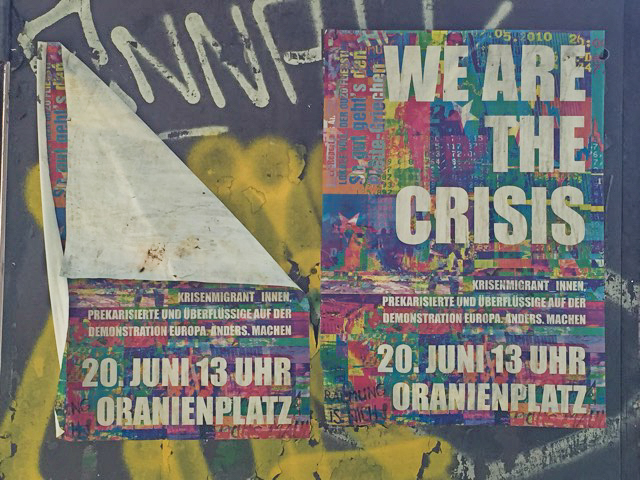Mark Fisher’s Capitalist Realism constitutes one of the clearest statements of what people for better or worse like to call the ‘postmodern condition’. On Fisher’s account, culture in the late capitalist world exists in a condition of stasis, having lost the impulsion to novelty that Fisher imputes to systemic competition with actually existing socialism.
In his most recent book, Ghosts of My Life: Writings on Depression, Hauntology, and Lost Futures (Zero Books, 2014), Fisher has collected a number of pieces mostly from his blog, in which he analyzes various products of modern culture.
From Joy Division, to Tricky, from The Shining to Blade Runner, and even Beloved, the former Wire editor shows the expected familiarity with broad swathes of popular culture, and its fringes.
As with Capitalist Realism, the theme that ties Fisher’s disparate analyses together is memory, its nature, its fragmentation, and its loss in the disintegration of the familiar narratives of capitalist modernity. Rather than a systematic and linear critique of postmodern market culture, Fisher’s writings in Ghosts of My Life compose a collage, one which, like the work of Hannah Höch in the 1920s, juxtaposes fragments in ways that illustrate the uncanny substratum of postmodern experience.
Reading Mark Fisher’s writings on culture, one is often reminded of the passage in Nietzsche’s “On the Advantages and Disadvantages of History for Life” in which he discusses the difference between human consciousness and that of animals:
Consider the herds that are feeding yonder: they know not the meaning of yesterday or to-day, they graze and ruminate, move or rest, from morning to night, from day to day, taken up with their little loves and hates, at the mercy of the moment, feeling neither melancholy nor satiety. Man cannot see them without regret, for even in the pride of his humanity he looks enviously on the beast’s happiness. He wishes simply to live without satiety or pain, like the beast; yet it is all in vain, for he will not change places with it. He may ask the beast–“Why do you look at me and not speak to me of your happiness?” The beast wants to answer–“Because I always forget what I wished to say”: but he forgets this answer too, and is silent; and the man is left to wonder.
Human beings, for Fisher, as for Nietzsche, are burdened by accretion of historical data. For Nietzsche, this contributes to man’s loss of the ability to act spontaneously in the project of revaluing all values. For Fisher, by contrast, history burdens memory with an abundance of fragments, creating an uncanny backdrop against which modern human beings are compelled to come to terms with their circumstances.
But unlike Nietzsche or, for that matter, any European who lived before the last third of the 20th century, those living in the present day do not have the promise of linear historical consciousness to discharge the buildup of historical desiderata. Whether via Christian eschatology or revolutionary socialism, European history has had a direction which provided both a sources of intelligibility for past, present, and future and the promise that the pieces of the puzzle of existence would all fall into place.
Late capitalism has changed all that. History is going nowhere. The past and future are being compressed into an ever-expanding now time which chugs along presenting the same as the different and going nowhere. Instead of a meaningful historical narrative moving from beginning to end, late capitalism is constructed on the model of circuits of capital accumulation, with progress toward heaven or utopia replaced by an endless repetition of M-C-M’ (or increasingly commonly M-M’).

In Capitalist Realism, Fisher makes the point that pretty much any current pop song could be read, without dissonance, into the popular culture of a decade ago. The newest thing about modern music is retro. Figures like Amy Winehouse and Adele built their popularity on riffing on styles even older than the ones that most modern musicians do. Fisher’s explanation for this seems to rest, to a great degree at least, on the lack of actually existing socialism as spur to cultural production (i.e. we here in capitalism land need new things in order to maintain the truism that you’ll have a better life here than in any of the alternatives). It’s hard to assess the truth of this idea, although the two things (the collapse of actually existing socialism and the reduction of popular culture to an endless rehash) seem to have happened in the appropriate temporal sequence.
Fisher is on firmer ground with his diagnosis of the current time. That which has been forgotten also comprises the futures that on which human hopes were based. What we are left with are fragmentary pasts and futures dissolved into spectral impossibility. The analyses in Ghosts of My Life circle around this condition, fleshing it out via various products of popular culture. Some work better than others. Fisher’s analysis of the written and filmic versions of The Shining is meticulous and effective, using both media to illustrate the psychosis inducing consequences of Jack Torrance’s entrapment in a historico-spatial loop.
Likewise, Fisher’s discussions of James Leyland Kirby’s ambient compositions convincingly highlights the ways that the composer plays with sound and memory to create sonic landscapes. Kirby’s brilliance is his approach to temporality. Fragments emerge and submerge unpredictably in his pieces, creating sonic textures that effectively mirror the circuits of consciousness in late capitalism.
Fisher’s clearly fascinated by electronic music, but here his analyses are more uneven. When talking about the work of Burial, Fisher’s discussion of the distant, longing of the pieces is quite convincing. His discussions of (and evident fascination with) Tricky are a little more difficult to swallow. It’s not that Maxinquaye isn’t an interesting record. One simply isn’t convinced at the end of Fisher’s piece that it’s quite as interesting as he thinks it is.
Still, overall Fisher makes a strong case for the analysis of postmodernism as a kind of ever spinning wheel in which culture is a sort of prop to late capitalist Entschlossenheit. Systems of reproduction of capital have reconfigured culture in their own Cartesian image: there is no here or there, just a series of temporary locations in a diaphanous cloud of memory fragments, some recreating the past, others foretelling futures the existence of which has now been foreclosed. What was once a source of understanding via the generation of meaning has now been reduced to a sort of idle chatter meant to distract one from the abyssal nothingness of capitalism in (what one hopes are) its last days.
Nietzsche’s aptly titled Untimely Meditations foresaw this condition. But for Nietzsche, firmly ensconced in the linear narratives of 19th century European historicism, the prospect of human existence freed from the crushing weight of historical accretions was utopic. It was a chance for men to reform themselves into supermen, as space in which the sclerotic values of European culture could be swept away by human beings prepared to take on the recreation of orders of value as a life project. But that dream (as is so often the case) has become a nightmare. Rather than opening up new spaces, the degradation of both history and memory have emptied the reservoirs of modern culture of the very substance that allowed people to view their situation with effective critical distance.
The artistic world in which Fisher involves himself provides various means to make this condition clear. But what to do about it is, as usual, another story. Much of the cultural content that Fisher dissects is too marginal to effect change at a broader social level. If the changes in culture are rooted in the circuits of capital reproduction, then that might be the place to start. But, of course, knowing that that is the case, and developing a strategy for doing something about it in a time frame prior to the exhaustion of the biosphere, are two different things. The question remains as to how to put them together. Critical culture for virtuosi isn’t bad thing. Critical culture with broader appeal is what’s needed to move the project of egalitarian culture forward.
Photographs courtesy of Joel Schalit.





